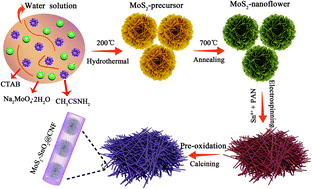MoS2 nanoflowers encapsulated into carbon nanofibers containing amorphous SnO2 as an anode for lithium-ion batteries†
Abstract
SnO2 with high abundance, large theoretical capacity, and nontoxicity is considered to be a promising candidate for use as advanced electrodes. However, the poor electronic conductivity and large volume variations hinder the practical applications of SnO2-based electrodes for use in lithium-ion batteries (LIBs). Herein, the MoS2–SnO2 heterostructures were encapsulated into carbon nanofibers (CNFs) via facile solvothermal and electrospinning methods. Remarkably, when the binder-free and robust MoS2–SnO2@CNF is employed as the anode for LIBs, such a clever structure yields a discharge capacity of 983 mA h g−1 at a current density of 200 mA g−1 after 100 cycles and a capacity of 710 mA h g−1 after 800 cycles at a current density of 2000 mA g−1. Moreover, full cells and flexible full cells were constructed, which exhibited high flexibility and delivered a high reversible capacity of 463 mA h g−1 after 100 cycles at 500 mA g−1. The exceptional performance of MoS2–SnO2@CNF could be attributed to the rational design of the electrode structure. On one hand, the robust structure of the amorphous SnO2 and MoS2 nanoflowers in the conductive carbon network not only provides direct current pathways, but also enhances electron transfer. On the other hand, the abundance of p–n heterogeneous interfaces considerably reduces the charge transfer resistance and enhances the surface reaction kinetics. This work proposes a feasible strategy to enhance the capacity and stability of SnO2-based electrodes and opens up a new avenue for the potential applications of SnO2 anode materials.



 Please wait while we load your content...
Please wait while we load your content...